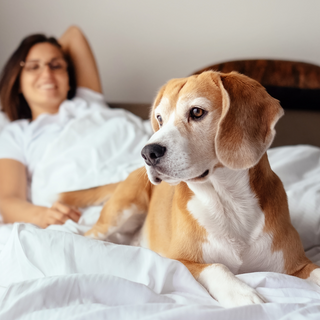Ten Tips for a Safe Halloween with Your Dog
Halloween brings excitement, costumes, and sugary treats, a celebration of imagination and autumn magic. But while we revel in the fun, our dogs often face a very different experience. From chocolate dangers to flashing lights and endless door knocks, this spooky season can be a minefield for them. To help keep tails wagging safely, Edition Dog has shared a series of daily tips as part of our Halloween Countdown. Here’s the complete guide, all in one place.
1. The Dangers of Chocolate
Chocolate may be a Halloween staple for humans, but for dogs, it’s one of the most dangerous treats around. It contains a chemical called theobromine, which is poisonous not only to dogs but also to cats, rabbits, and rodents. The darker the chocolate, the higher the theobromine content, and therefore the greater the risk of poisoning. Even white chocolate, though low in theobromine, is still high in fat and can cause pancreatitis, a painful inflammation of the pancreas. Dogs that consume large amounts of chocolate can develop symptoms such as vomiting, tremors, muscle twitching, and potentially life-threatening heart issues. Keeping all chocolate securely stored and out of reach is one of the simplest ways to prevent a Halloween emergency.

2. Sweets and Artificial Sweeteners
Trick-or-treating means piles of sweets, and for dogs, the temptation to steal them can be intense. Consuming large quantities of sugary or fatty treats can cause pancreatitis, leading to vomiting, lethargy, and even organ failure. But the real danger lies in sugar-free sweets containing xylitol, a common sweetener that’s incredibly toxic to dogs. Xylitol can cause a dog’s blood sugar levels to plummet within minutes, resulting in seizures, liver failure, or death. Though more common in American products, xylitol is now appearing in UK sugar-free gums and sweets, so vigilance is essential. Always keep your Halloween treats well out of paw’s reach.
3. Bobbing for Treats
Halloween fun doesn’t have to be off-limits for dogs. A great way to involve them safely is through a dog-friendly version of bobbing for apples. Fill a shallow tub or small pool with water and add slices of dog-safe fruit, like an apple(without the seeds), or small cubes of pumpkin. It’s a fun, sensory game that stimulates their mind, cools them down, and offers a tasty, healthy reward. Unlike sugary human treats, these snacks provide enrichment without risk, proving that safe can still be fun.
4. Candle and Pumpkin Safety
Few things look as festive as glowing pumpkins, but they come with hidden hazards for pets. Candles and candlelit pumpkins should always be kept well away from wagging tails and curious noses. A knocked-over candle can easily burn your dog or even start a fire. Battery-powered tea lights are a safer alternative, but they’re not risk-free. Chewedbatteries can cause chemical burns and poisoning. Always place lit or glowing decorations securely out of reach, and never leave them unattended around pets.

5. The Doorbell Dilemma
Halloween night often means an endless stream of knocks, doorbells, and strangers in masks — a sensory nightmare for many dogs. Even confident dogs can feel uneasy when familiar people suddenly appear disguised or move differently. Set your dog up for success by creating a quiet, comfortable space away from the front door, complete with toys, treats, and gentle background noise. If you’re heading out to trick-or-treat, it’s best to leave your dog at home, where they’ll feel calm and secure.
6. Spooky Decorations and Startled Dogs
Halloween decorations are designed to surprise with flashing lights, sudden sounds, and moving figures, but those same effects can terrify dogs. Always keep your dog on a lead during walks, even if they’re usually reliable off-lead, as unexpected noises or movements can cause them to bolt. Make sure their collar or harness fits correctly and that their ID tags are up to date, just in case they get spooked and manage to slip free. Prevention is far safer than panic.
7. Dog-Friendly Halloween Events
Not every Halloween activity needs to be scary. Many local communities now host dog-friendly events, such as pumpkin patch walks or themed fundraisers, where dogs are welcome. These can be a lovely way to socialise your dog in a controlled, positive environment. Always check that the event is clearly marked as dog-friendly, keep your dog on a lead, and bring essentials like water and waste bags. That way, both you and your dog can enjoy the festivities together safely.

8. Rethink Walk Times
If your usual walk time falls during peak trick-or-treating hours, consider adjusting it. An earlier or later walk can help your dog avoid the noise and confusion of costumed children, flickering lights, and loud music. It’s also worth remembering that fireworks often begin in the days leading up to Halloween. Dogs have far more sensitive hearing than humans, and even distant bangs can trigger fear or panic. A calm, daylight stroll is often the safest choice.
9. Children and Costumes
Halloween brings more children into neighbourhoods than usual, many of them dressed in colourful costumes and full of excitement. For dogs, this can be overwhelming. Constantly monitor how your dog reacts around children and be ready to intervene. Keep them on a lead and politely discourage children from approaching if your dog appears anxious. Masks and costumes can make even familiar faces seem strange, so give your dog space and reassurance to prevent stress or fear-based reactions.
10. Comfort Over Cute
Costumes might make for great photos, but not all dogs enjoy wearing them. Some will tolerate a light outfit, while others freeze, pant, or try to wriggle free, evident signs of distress. If your dog seems uncomfortable, remove the costume immediately. Safer alternatives include a bandana or festive collar. Avoid dressing cats entirely, as most find it extremely stressful. Even calm dogs should only wear costumes for short periods under supervision, as body coverings can cause overheating and interfere with their ability to communicate body language through tail and ear movement.
As Halloween approaches, take time to plan. Store sweets securely, keep candles and decorations out of reach, adjust walk times, and provide your dog with a safe retreat from the noise and commotion. The aim is simple: a fun night for you, a stress-free evening for them. Together, we can make sure this Halloween is filled with treats (not tricks) for every dog.
- Choosing a selection results in a full page refresh.


